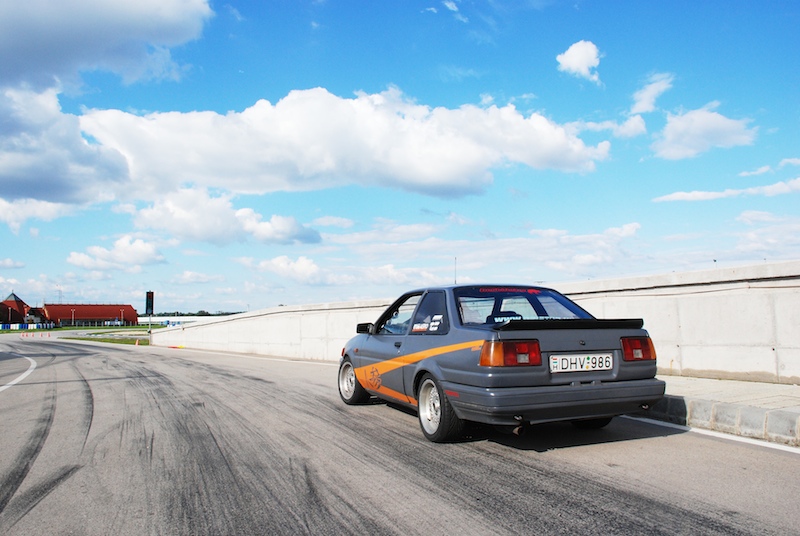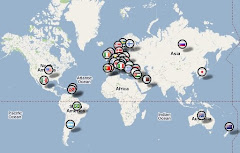...and here we are. Losing all unnecessary words, let's just say, without racing, cars would be just boring metal-boxes, carrying people from A to B, pumping adrenalie no more than a ride on a subway would. But thank God for racing spirit, no sooner the second car left the factory, the setting has been paved for competitive purposes. So now, let's take the ultimate forms of CAR racing here. See if you get hooked on some of them.
10. Truck Racing
No, this is not the NASCAR pickup roundabout (although more exciting to watch them as "general" "stock" cars, IMHO). It is the real deal. The clash of the Titans. A complete nonsense this is - vehicles designed explicitly for commercial trafficing squeezing through corners side by side on tracks that were put down on blueprint with small, competitive one-seaters and motorcycles in mind. Howling tyres, clouds of vapour and smoke as the rig trucks drift on six wheels for the checkered flag. Like skyscrapers going down, the sight and the rumble of the action resembles some sort of apocalyptic scene from the end of the world. Mad Max would approve, too.
9. IndyCar
"Stone-age Formula 1" - one would think. And I agree, but that is the point. But let's hold the horses for a minute and get deeper a little bit. IndyCar is one of the oldest seres out there (not formally though), originating from the legendary Indianapolis 500. Since the dawn of formula 1, there has been a growing demand to extend the biggest motor racing event in the world to a series, thus CART was created. Indy cars in the beginning wore strinking resemblance of F1 cars, but as the time of aerodynamic design moved forward in the late 60s, they took a different direction in engineering - as Indy still being centered around Indianapolis Motor Speedway and other oval tracks. No wonder, general development still went towards engine power, even after F1 started backing down. In general, an Indy car is a much cheaper design than an F1, and lately it has become a spec series. Equal cars fighting through ovals and street circuits, being similar to F1 racers 20-25 years back (especially with the new formula from 2012), they sometimes bring the same excitement as those races back in the day. That alone makes it to be on the list.
Although these are two different leagues and series, they should be mentioned together, as there are barely any difference between them - cars are even shared for the most part. Rallying is probably one of the oldest racing forms out there - cars going from A to a very distant B, crossing the finish line. Although the competition has moved since then to a Super Special mayhem, one gist is still there that cannot be compensated by anything - the complete inability of putting this on live TV. Heck, a whole event goes on for a full weekend, and cameras cannot be put everywhere. People tried and failed: a live SSS coverage is fun, but feels more of an X-games event for the purpose of showing off. It took time to realize: this is a race for the hardcores. For those people who are willing to go out in the forest, at night, in the snow, just to watch the flashes and thunder one at a time, for a few seconds. This is love at its deepest. Although downsizing in the past decades has left its negative mark on the popularity of the sport, it still deserves to be on the list.
7. Dakar
The true meaning of rallying. As detailed no. 9, Super Special explicit runs make up a rallying event in the World Championship. Not in Dakar rallying. The greatness of a racing event is being indicated whether a whole series will grow out of it, as we saw it earlier, and as we will later on. The challenge on the African sand dunes has been altered from year to year due to political fear. First, not putting the finish line in Dakar, then moving out of Africa entirely, setting in South America. But the name is still there, symbolizing one of the toughest motoring competition known to mankind. Motorcycles, 4x4s, trucks unleashed into the endless savannah, hoping to see the checkered flag in the end, or to achieve a DNF alive for the worst. A journey through the wilderness. Not many motorsports earn its living of that.
6. NHRA Top Fuel
Racing at its main core, in the league of ultimates - concerning the duration of a race, the horsepowers involved, the g's, the top speed, the sound, the adrenaline. There is just no way to top this. F1 cars are always being compared to jet fighter planes, top fuel dragsters then should be matched up with rockets. They are indeed rockets with their 8000bhps, the "driver's" job is to aim the beak to the finish line 1,320 (or 1,000) feet away during those crucial 4 seconds. Nothing compares to the thunder and lightning experience these vehicles give. You have to see it for yourself.
5. Formula Off-Road
Take the previous two contestants and this is what you get. The other one would be top fuel sand drag racing. But this is more exciting. You have the nitrous fire-breathing V8 from a dragster, fitted with the same tyres with treads big enough for speedbumps, putting them in front of a vertical piece of mine-wall, and there you have it. Vehicles seemingly defying gravity, climbing up the wall as quick as other cars at a green-light start. Or put a lake between them and the finish line, and they would cross it easily... on the surface of the water. The craze that started in Iceland, is the most redneck motorsports of all, and it wasn't even invented in America - with this much fury at least. Insane drivers and vehicles. A much watch for every offroader and anyone in general, whoever saw a car at any point of his or her life.
4. DTM
Probably the most significant and yet most underrated spec-racing in existence - a perfect synthesis of NASCAR and touring car racing with a great hint of F1. Cars are very much like their Americans counterparts in their general layout, but they look ridiculously more fenomenal, running on tracks where ususally F1, touring car, and other prestigeous races are dominant. A defunct series with a magnificent revision and revival, quickly conquering Europe, stepping over to China, and rumors say, in 2013 a DTM NASCAR series for America will be launched due to the excessively successful formula. You get all the contacts that are acceptable in any NASCAR or touring car race, a real man-to-man fight, also, equipped with the sound of early 90s F1 cars. Take that, and consider Mercedes and Audi fighting against each other, clashing the Silver Arrows in numbers enough for a whole league. Plus, it is a haven for ex-F1 drivers, who now can show their more immediate, agressive faces pushing each other around. 2012 will see the return of BMW as well to complete German supremacy once more. There is scarcely anything to say against it.
3. Formula 1
The King of Motorsports remains the de facto King of Motorsports. De jure it is a little bit different, for it is a bad king lately. F1 suffers from a serious identity crisis, mostly since the beginning of the electronic age - concerning driver aids. Driving aids were banned, leglized and banned again due to the conflict of interests whether F1 is a drivers' skills sport or a technology-driven one. Literally. With driver aids turned on, it's more of a technological sport, turned off, it's less F1. Along with budget restrictions and simplifications, most of the great companies started losing interest lately, leading to a near split. I, myself have dealt with a possible solution, too, because the problem is permanent. Yet, it is still the ultimate benchmark of automobile racing and will be for a long, long time afterwards.
2. 24 Hours of Le Mans
If big car companies moved from F1, where are they now? Well, they are all here, between two small French villages. Seperated at birth, the Le Mans 24 Hours and F1 took very different routes, with the former gaining full attention of manufacturers. A win at Le Mans means a lot more to a company professionally than three world titles in a row in F1. Because the knowledge and know-how gained in F1 is being recycled into itself for the most part, experience gained from a 24 hours race here can be used on everyday cars as well. That's why it is no sacrilage that diesels are winning all the time lately, and most cars sold in Europe are diesels, too. This is the real proving grounds of automobile engineering. In addition, racing-wise, it is the perfect combination of man, machine and TEAM. A lot less individual sport than F1. Maybe this is one of the reasons there aren't as many followers of this sport as F1, people find it more difficult to build up a relation with it, whereas in F1 it is a lot more easier to get affected by the drivers themselves. The question in F1 is usually whether X driver would be faster than Y that year. In endurance racing, the main discussion travels around whether Peugeot could beat Audi once more or so. There are several series originating from this single event, but this is the holy ground, right here. In my opinion, the de jure King of Motorsports is the 24 Hours of Le Mans.
1. Pikes Peak International Hill Climb
What? How? I just claimed the Le Mans 24 Hours "KoM". How come it only came in second? Because here is the "King of Motoring Challenge". You can't and won't stay up for 24 hours just to watch Le Mans, will you? I suspect everyone slept one hour or two in the early hours. But the Pikes Peak International Hill Climb is very different. It is a well balanced combination of the most exciting motorsports. Of course, it is a hill climb. Which means, you get a solitary time attack with enourmous elevation. It resembles rallying a bit in this respect, even more when talking about cars, including ones that are sometimes basically indy cars converted for dirt roads, but most of the time, vehicles that recall the best days of Group B rallying and Japanese silhouette racing. And some more. Literally, there are no limits but the finish line in the clouds. Hereby I proclaim the Pikes Peak International Hill Climb the ultimate form of automobile competition.
+1. Drifting
Drifting deseves a whole different section, for it is much closer to figure skating than straight racing. Drifting is the motorsport for the YouTube generation who grew up on Group A and Group B videos back in the day. Drifting takes the most spectacular bits of rallying and touring cars, and extends it to a whole event. For sure, a car is most exciting to watch when going sideways. Especially when there are two or more of them trying to get to the front. And where else can you find a motorsport where small Japanese four-banger hatchbacks are equals of monstrous American V8 and V10 supercars? Truly, truly a drivers' competition. All skill, all handling. That is all that matters for the most part.
























